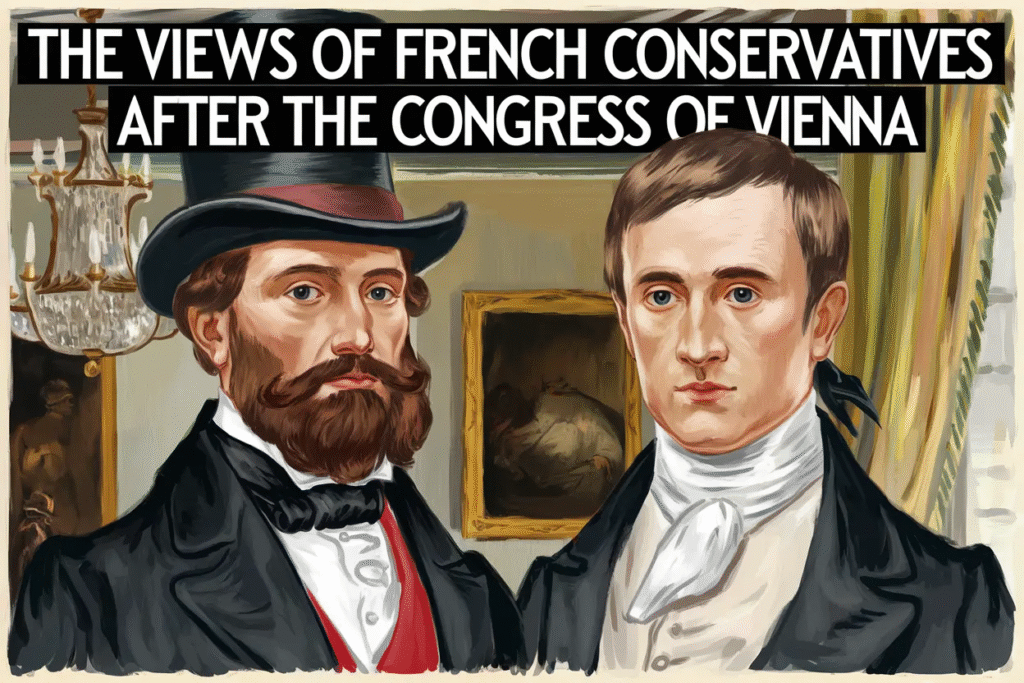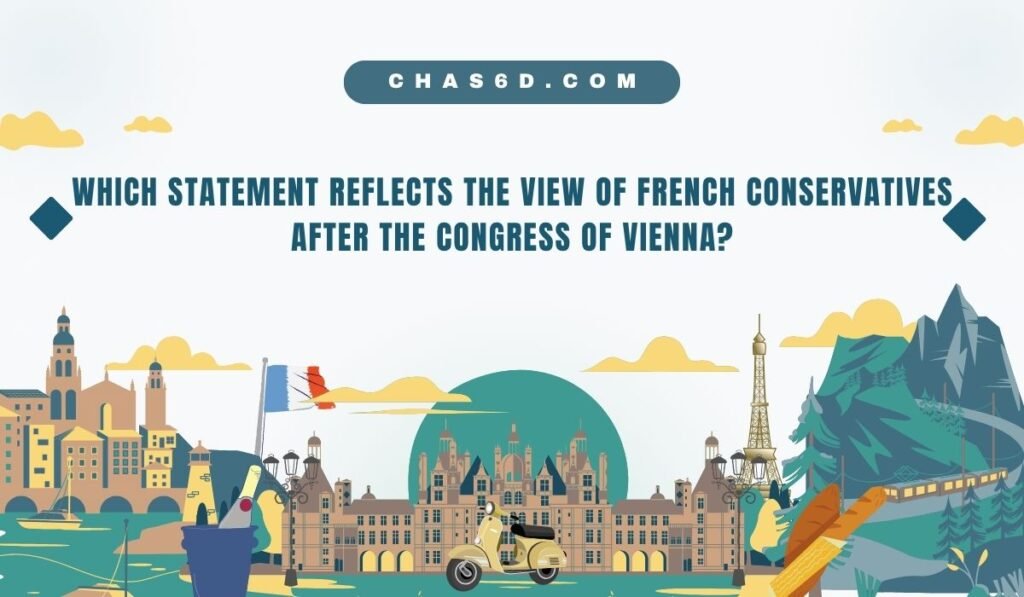The Empire Falls, the Question Rises
The cannons had gone silent. Napoleon was gone. Waterloo was over.
In the heart of Europe, in a city of chandeliers and whispers—Vienna—kings, ministers, and old noble blood gathered to redraw the map. But while diplomats debated borders, one shadow loomed larger than any army: Revolution.
Among the velvet-draped halls stood the French conservatives—quiet, cautious, and deeply scarred. These were men who had survived guillotines, exile, and the death of everything they once believed eternal. Their agenda wasn’t just territorial—it was existential.
Someone asked:
“Which statement reflects the view of French conservatives after the Congress of Vienna?”
And from that corner of silence came the answer:
“Only monarchy, guided by tradition and protected by faith, can prevent France from descending into another revolution.”
That wasn’t a slogan. That was a vow.
Revolution Was Not an Idea—It Was a Nightmare
To understand conservative France after 1815, you must see the world through their eyes.
They had watched mobs rip power from the king’s hands. They had seen churches looted, priests murdered, and nobles stripped of everything. They had tasted a world with “liberty” on its tongue and blood in its mouth.
To them, the Revolution wasn’t progress—it was disaster.
So, when the Congress of Vienna offered the chance to restore order, they saw salvation. For French conservatives, the guiding principle became clear:
“A stable society cannot be built on freedom alone. It must rest on pillars older than any constitution—monarchy, religion, and hierarchy.”
And those pillars had to be restored, brick by brick.
The Charter of 1814: A Mask of Modernity
King Louis XVIII returned to the throne in 1814, but he did not return to the same France.
He faced a nation where the monarchy had fallen, the nobility was scattered, and the people had tasted rights. Revolution had left scars, but it had also left expectations.
So Louis offered a compromise: The Charter of 1814.
On paper, it was liberal. It promised civil rights, a constitution, and two legislative chambers. But beneath the paper-thin progressiveness lay a deeply conservative soul:
- The king still controlled the military and foreign policy.
- Voting was restricted to wealthy landowners.
- The nobility regained social privileges.
- The Church was reinstated as the moral compass of the nation.
To conservatives, the Charter was not a surrender—it was a shield. A way to pacify the present while preserving the past.
“Give them the form of freedom. Keep the heart of power untouched.”
IV. The Return of the Cross: Church as the Spine of Society
The Revolution had tried to bury the Church under rubble and reason. But to conservatives, that was the true sin.
In their worldview, God and King were not separate—they were intertwined. Where the Church had been cast out, chaos had rushed in.
After Vienna, conservatives championed a rebirth of Catholic authority:
- Religious education returned to schools.
- Anti-clerical writings were suppressed.
- Clergy were restored to public office.
- The Church regained ownership of confiscated properties.
Why? Because they believed:
“Only faith can tame the hearts of men. A society without religion is a society without conscience.”
The return of the altar was as vital as the return of the throne.
The Ultraroyalists: More Monarchist Than the King
Not all conservatives were the same.
A fierce faction emerged: the Ultraroyalists—nobles, clerics, and royalists who wanted not just restoration, but resurrection of pre-revolutionary France.
They rejected compromise. They despised the Charter. They demanded:

- Complete power for the king.
- Elimination of revolutionary laws.
- Total dominance of the Church.
- Punishment of former revolutionaries.
Charles X, Louis XVIII’s brother, embraced their cause in the 1820s. Under his rule:
- Press freedoms vanished.
- The tricolor flag was replaced by Bourbon white.
- Public criticism of monarchy became treasonous.
Their motto was clear:
“France doesn’t need reform. It needs repentance.”
But their excesses triggered backlash. In 1830, the July Revolution erupted, and Charles X was forced into exile.
Still, their voice lived on—in shadows, in salons, in whispers.
The Pyramid of Power: Hierarchy as Natural Law
French conservatives didn’t just defend monarchy and religion—they defended structure.
They believed society functioned like a pyramid:
- The King at the top.
- The nobility as guardians of tradition.
- The clergy as moral guides.
- The wealthy as economic stewards.
- The poor as loyal laborers.
Revolution had tried to flatten this pyramid—and chaos had followed.
Conservatives feared:
- The rise of the middle class.
- The demands of workers.
- The idea of “equality.”
To them, equality was an illusion that led to disorder. Order came from knowing one’s place.
“Justice is not sameness. Justice is harmony—and harmony needs hierarchy.”
The Brotherhood of Thrones: A Continental Crusade
French conservatism was part of a larger European mission.
After Vienna, monarchies formed an alliance—the Holy Alliance—led by Austria, Russia, and Prussia. Their goal? Prevent revolution anywhere and everywhere.
France, though recently humbled, joined this sacred cause. Together they pledged:
- Mutual defense of monarchies.
- Suppression of liberal revolts.
- Censorship of revolutionary ideas.
- Surveillance of dissidents across borders.
To conservatives, this was more than politics—it was a spiritual war against modernity.
“One fallen throne weakens them all. If Paris falls again, Vienna and St. Petersburg may be next.”
The Philosophers of Reaction: Thought as Weapon
Behind the policies stood pens.
Conservative thinkers like Joseph de Maistre and Louis de Bonald armed monarchists with ideology:
- They rejected Enlightenment reason.
- They exalted tradition over progress.
- They saw revolution as rebellion against divine will.
- They argued that political authority flowed from God, not the people.
De Maistre famously said:
“Every nation gets the government it deserves—but some are wise enough to accept the one God gives them.”
Their ideas spread through journals, salons, and universities—fortifying the next generation of conservative leaders.
So… Which Statement Reflects the View of French Conservatives After the Congress of Vienna?
The time has come to answer the question in full:
Which statement reflects the view of French conservatives after the Congress of Vienna?
Here is the most complete and historically accurate reflection:

“Only the restoration of monarchy, religion, and social hierarchy can preserve France from the chaos of revolution and the moral collapse of modernity.”
This wasn’t just rhetoric. This was their mission, their faith, their fear.
Everything they built—or rebuilt—after 1815 pointed back to this single belief.
Caught Between Two Fires: France in the 19th Century
For the next hundred years, France would swing like a pendulum between:
- Monarchy and Republic.
- Church and Secularism.
- Order and Uprising.
But one truth remained:
The conservative view never vanished. It transformed, adapted, and re-emerged in new forms.
Even in the age of democracy, echoes of 1815 could be heard:
- In resistance to liberal reforms.
- In nostalgia for lost grandeur.
- In the belief that too much freedom invites disorder.
That’s the true legacy of the Congress of Vienna—not just redrawn maps, but revived mindsets.
Final Reflection: The Fear That Built a Philosophy
French conservatives after the Congress of Vienna were not just defenders of monarchy. They were guardians of memory—memories of terror, chaos, and collapse.
They believed France could not afford to gamble again with revolution.
So they chose safety in structure. Meaning in monarchy. Morality in religion.
Their worldview, built on loss, shaped France long after Napoleon’s shadow had faded.
And in the answer to the question—“Which statement reflects the view of French conservatives after the Congress of Vienna?”—we find not just history, but the heartbeat of a nation at war with its own past and future.
For more visit website: chas6d


